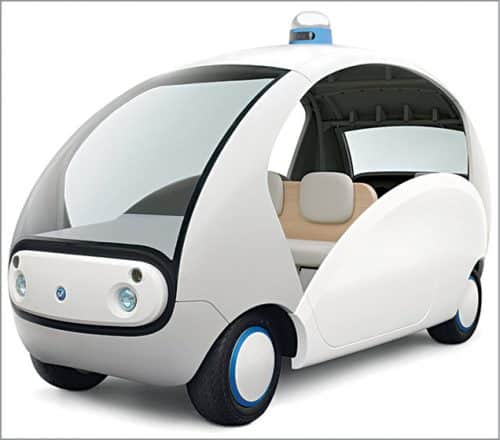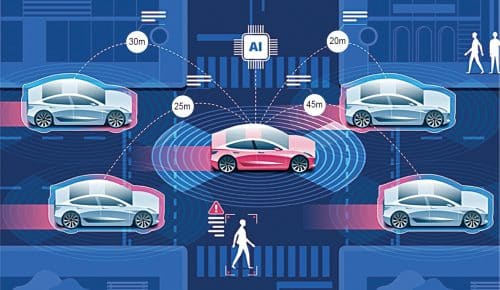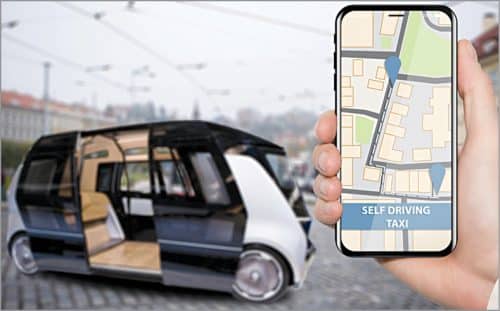The development of self-driving vehicles with increasing safety is fast progressing and may become a reality in the near future. Technological advancements are constantly revolutionising not just the automotive industry but human transportation in general.

Automotive information technology (IT) generally refers to hardware or software designed to enhance and boost the experience of driving or riding a vehicle. Generally, the objectives of automotive IT include improving the performance of automotive systems, enhancing the safety of motor vehicles, making useful data available to the operators, and providing better entertainment experience to passengers.
This is done by equipping vehicles with various types of computers, software, sensors, cameras, and radar systems. Automotive IT helps in providing a number of innovative features in smart cars such as assisted parking, self-braking systems, collection of data for predictive maintenance of the vehicle, and assisting road maintenance agencies in carrying out timely maintenance.
Autonomous self-driving cars can function without human control using cameras and sensors. Biometric systems, such as fingerprint sensors, face scanners, and iris scanners, allow only the owner to access the car. Buttons and knobs are replaced with voice assistants. For instance, the car windows can function with touch screens and gesture controls.

Other smart features include self-assisted parking to provide safety against imminent collision, computerised diagnostics, GPS-based navigation, remote keyless entry using smartphones, lane detection while driving, and over-the-air (OTA) update systems.
Continuous improvements are taking place to assist the automotive industry in delivering the most advanced, safest, and comfortable vehicles to its customers. While a few companies have been developing and testing self-driving prototypes on open roads, a number of manufacturers are already providing semi-autonomous capabilities, including automatic braking sensors, motorway lane sensors, and mapping technology. The future automobiles will provide drivers and passengers an extremely smooth journey and enable them to read, watch TV and work while just sitting inside their moving vehicles.
Evolution of automotive IT
Nicolas-Joseph Cugnot developed the first steam-powered automobile in 1769, and Karl Benz started the production in 1885. Later, Henry Ford created an automobile assembly line for mass-production. The Ford Model T was the first car to be mass-produced. Not long after Ford’s Model T, automakers’ focus shifted to outdoing one another on the basis of automobiles’ speed, power, luxury, and performance. This lead to increased use of IT in the automotive industry for creating cars that were safer, faster, more comfortable, economical, and environment friendly.
Today, IT is working towards the goal of bringing self-driving smart vehicles in the automotive industry. Some of the exciting new technologies enabling the creation of advanced future vehicles are improved software platform for autonomous ride-sharing service, predictive maintenance technology, self-balancing algorithms for personal pods, and new infrastructure designs for autonomous fleet vehicles.
In future, drivers will be able to control vehicles with just a wave of their hands using a 3D gesture technology system. They will be able to close and open windows by simply waving hands up or down, take an incoming call and control the airflow, temperature, etc, by pointing towards the screen of the infotainment system.
Predictive maintenance
Predictive vehicle maintenance determines when a vehicle needs to be serviced. The technology evaluates the vehicle’s performance and informs the user about safety hazards. Artificial intelligence (AI) and machine learning (ML) have a dominant role in providing predictive capability by personalising a driver’s driving experience and connecting vehicles to smartphones to take voice commands. Algorithms automate the process and update the optimal vehicular performance over longer periods of time. Remote servicing is also becoming a possibility. An example of predictive maintenance is Michelin’s tire monitoring program that uses telematics and predictive analysis to monitor over-the-road tire condition in real time.
The collected data is fed into a computer to carry out real-time analysis of wear and tear of tires to identify the problem before it actually occurs or is close to it. The system maintains a continuous link between OEMs and customers, even as owners of vehicles change.
Communication with vehicles, infrastructure and networks
Imagine you are approaching a traffic light, and a vehicle suddenly jumps a red light. Though you fail to react to a sudden situation, your car provides a warning of a likely collision and applies brakes automatically in split seconds to avoid an accident. This is possible with vehicle-to-vehicle communication or V2V.

Wireless signals send information back and forth between vehicles about their location, speed, and direction to enable them to maintain safe distances from each other. V2V algorithms determine the best evasive measure required to preclude an accident. Vehicle-to-infrastructure (V2I) technology is a communication structure that enables many vehicles to share data with a range of devices supporting the highway system of a given country.
These devices include RFID readers, signage, cameras, lane makers, streetlights, parking meters, and more. Enabled by a network of hardware, software, and firmware, the V2I technology is usually wireless and bi-directional. It enables vehicles to communicate with infrastructure, such as road signs, traffic signals, and traffic management systems (TMS), to provide information about safety issues and the best possible route to take based on the prevailing traffic conditions, accidents, or breakages.

V2I also allows autonomous parking
A garage or parking area ‘talks’ to the vehicle via the Internet and informs about the free space. After dropping off passengers, the vehicle approaches the free space and automatically parks itself. To get the vehicle back from the parking, the driver has to just make a call using his/her smartphone. A recent study by the National Highway Traffic Safety Administration (NHTSA) has reported that V2V systems, together with V2I, could reduce road accidents by about eighty per cent.
Augmented reality dashboards
Augmented reality (AR) display can overlay information on top of what a driver is actually seeing in real life. BMW has already implemented a windshield display in some of their vehicles, which displays basic information. They’re also developing augmented reality dashboards that will help identify any external object in front of a vehicle and inform the driver how far away he/she is from that object.

So, if a driver is approaching another vehicle too fast, a red sign will appear on the approaching vehicle’s windshield, and directions will be displayed showing how to manoeuvre to avoid collision.
BMW is also researching the use of AR for technicians. Using AR glasses, technicians will be able to find which part of the vehicle needs to be serviced or replaced. The display will show the step-by-step instructions on how to go about the entire process.
AR is also being researched to allow passengers to zoom in on objects outside the car and select, identify, and view the object using a touchscreen window.
Airbags help stop cars
Airbags will not only provide improved protection to passengers but also increase the stopping power of automobiles in future. Mercedes is working to make airbags part of its vehicle safety system (VSS). The company is experimenting with airbags that deploy from underneath the car and help stop a vehicle before a crash.
These airbags are part of the overall active safety system and deploy when sensors determine that impact is inevitable. The bags have a friction coating that slows the car and can double the stopping power of the vehicle. The bags also lift the vehicle up to eight centimetres, which counters the car’s dipping motion during hard braking, improves bumper-to-bumper contact, and helps prevent passengers from sliding under seat belts during a collision.
Energy-storing lightweight body panels
Manufacturers are researching and testing body panels made of polymer fibre and carbon resin that are strong, pliable, light in weight, store energy, and also charge lithium-ion batteries. These are capable of capturing energy produced by regenerative braking or when the vehicle is being charged overnight. Energy is then released as per the vehicle’s demand.
Body panels are also being developed for capturing and storing solar energy. One of the major problems faced in designing hybrid vehicles is that batteries have a significant amount of weight and occupy a lot of space. This is where energy-storing lightweight body panels come to play.
Wireless technologies
Wireless technologies such as LTE, Wi-Fi, Bluetooth, and 5G allow vehicles to communicate with infrastructure (V2I), network (V2N), people (V2P), and one another (V2V).
Continuous advancements are being made by automobile companies such as Toyota, Lexus, and Volkswagen and chip designing and manufacturing companies like Qualcomm and NXP. These advancements include technologies for faster data transmission, improved safety of vehicles, reduced latency of less than five milliseconds, and better data sharing.
Level-4 autonomous vehicles
As per the norms of Society of Automotive Engineers (SAE), level-0, level-1, and level-2 autonomy include advanced driver-assistance systems (ADAS) that have the capability of controlling vehicles autonomously in limited and brief conditions. These systems mainly include adaptive cruise control, parallel parking capability, and collision avoidance.
Level-3 or level-4 autonomy refers to driverless cars with autonomy and the ability to make decisions on their own. Companies like Waymo, Cruise, Uber, Lyft, Argo AI, and Voyage are approaching level-3 autonomy using a ‘Safety Driver,’ which is currently at the development stage. When level-4 vehicles would become a reality, accidents and traffic would get reduced drastically, and there would be no drunk driving incidents.

The problem being faced in reaching level 4 is that enough ‘categorised data’ is not available to teach vehicles how to drive in millions of different case scenarios. Another problem is the complete optimisation of algorithms to decide where the car should go based on the inputs from the available data.
To support such software in a fully autonomous vehicle, the hardware requires an incredibly fast and powerful embedded system, such as the NVIDIA Drive AGX Pegasus platform, capable of 320 tera-operations per second (TOPS). Efforts are on to create a computer platform capable of solving complex algorithms in real time with minimal power consumption. In the coming years, some impressive technological breakthroughs using AI, ML, and data characterisation are expected.

Autonomous micromobility
Micromobility refers to a range of small, lightweight devices operating at speeds typically below 25.6kmph and making trips under 15km. Micromobility devices include e-bikes, electric scooters, electric skateboards, shared bicycles, and electric pedal-assisted (pedelec) bicycles. This category has evolved to exclude devices with internal combustion engines and those with top speeds above 45kmph. This is one of the fastest-growing sectors of mobility in the world.
Autonomous micromobility will help alleviate congestion by maximally packaging humans on roads. Uber is developing autonomous e-bikes and scooters that will drive themselves to charging stations. Autonomous micromobility will provide the ability to communicate road and traffic conditions to other vehicles using V2V technology along with the accelerated road-mapping capability to map roads better and faster.
Technology for vehicles ‘to see’
Capability ‘to see’ is the key to autonomous vehicle safety. Devices that are needed to make vehicles ‘to see’ the road around include cameras, light detection and ranging sensors (LiDAR), automotive radars, and ultrasonic sensors. Software is used for ‘fusing’ these different sources to localise the detected objects and predict where these will go next.
Cameras
Cameras capture an image by recording the light reflected by the object’s surface and provide clear images if the light intensity is sufficient. Cameras are continuously being made smaller, faster, higher-performing, and less expensive. Technology is available to decipher 3D images from the camera using a camera processing unit for detecting obstacles such as curbs and potholes. A new technology called DeepRay uses AI to reconstruct footages from damaged or obscured frames in real time to allow vehicles ‘to see’ during rain and snow.
Ultrasonic sensors
An ultrasonic sensor measures an object’s proximity by using a transducer to send and receive ultrasonic pulses relayed by the object. Ultrasonic sensing is usually used for short-distance applications at low speeds such as self-parking and blind-spot detection. The technology is also used in vehicle detection systems to automatically count the number of vehicles entering or leaving an area such as a parking lot and highway gates. In case of low light intensity, or when a medium interferes with the propagation of light, cameras provide poor quality images. This problem is solved by combining cameras with ultrasonic sensors that function well in conditions where light intensity is low, or the surroundings are dark. The advantages of ultrasonic sensors are their smaller size, relatively cheaper price, easier implementation, and lower power consumption.
Automotive radars
Automotive radars are used to determine speed, direction, and range of objects in the vicinity of a vehicle by transmitting radio waves, which after hitting an object, get reflected and are received by radar. Frequency-modulated continuous-wave (FMCW) radars are simpler than pulse-doppler radars as the hardware required is considerably less complex, and the digital processing requirements are simpler. Automotive radars complement vision-based camera-sensing systems and are used in ADAS for collision avoidance and detection of pedestrians and cyclists.
LiDAR sensors
LiDAR measures distance by illuminating the target with laser light and measuring the reflected light. Solid-state LiDAR technology provides sensors that can determine the velocity of the object as well as its distance from the radar. Efforts are on to make LiDAR sensors that can see as far as 200 metres with 2.5cm precision using only 100mW of power. Plus, these cost less than 500 dollars.

Trends in electric vehicles (EVs) technologies
Smaller and more efficient electric motors
Electric vehicles (EVs) are better performing, more efficient, luxurious, and above all more durable and less expensive. EVs can be made smaller with the same interior volume by reducing the electric motor size. Also, with reduced weight, a less powerful motor is required.
Brushless DC (BLDC) motors and AC induction motors are used in most of the electric vehicles considering their efficiency, availability, lack of wear elements, and regenerative braking capability. Several other concepts are also being developed, such as asymmetric motors, e-propulsion systems, high efficiency switched reluctance motors and inverter-driven AC induction motors. Another emerging technology is axial flux motors, where magnetic flux is produced along the axis instead of the sideways of the rotor.
The most favourite technology being used for applications like scooters and e-bikes is electric direct-drive in-wheel motors or hub motors. These provide distinct benefits like individual control of each drive wheel’s speed, torque, traction, and regenerative braking. Fully hidden hub motors take up hardly any additional space.
The problems faced in using the hub motors are unsprung weight and inertia. The wheel with the motor in its hub becomes heavier, making it harder for the vehicle to accelerate. Also, when the wheel hits a bump, the suspension is required to make extra effort to put back the wheel on to the ground, making for a rough ride. With hub motors, the rotational mass of the wheel increases, and greater power is required to move the vehicle.
These problems are surmounted by using more active suspensions that forestall bumps to prevent a rough ride. With each wheel having one motor, motors become smaller, and weight addition is considerably reduced by having an appropriate housing and wheel structure.

Solid-state batteries
The conventional lead-acid batteries are large in size, heavy, and charge slowly. Lithium-ion batteries solve most of these issues as these are smaller in size, lighter in weight for the same voltage, and have more charge cycles, thereby lasting longer. These cost more than lead-acid batteries but are safer for the environment as these hardly emit any carbon.
For an EV having the same range as a conventional vehicle, the weight of lithium-ion batteries required would be considerably more than a tank of gas.
Solid-state battery technology provides batteries that are as small as a gas tank, weigh a similar amount, get fully charged in only a few minutes, and provide an energy density 2.5 times of lithium-ion batteries. The added advantage is that these are not flammable. However, these batteries are expensive, and there are concerns about low-temperature performance and mechanical durability.
Faster electric charging
Rapid advancements in electric chargers and charging infrastructure is taking place to cut down the charging time drastically. Gbatteries has recently developed an electric car charger that lets the car charge quickly. Another emerging technology is wireless or induction charging that is similar to wireless mobile phone charging but at considerably higher power.
Qualcomm Halo has been working on a 22kW wireless charger with the possibility of charging vehicles while they drive up to 113kmph. Nissan, Mercedes Benz, and BMW are also developing wireless charging capability in their vehicles.
Conclusion
Today, the automotive industry is one of the most data-driven industries. The modern smart and intelligent vehicles use software systems and collect enormous data pertaining to the functioning of various systems, drivers’ behaviour, preferences and condition, routes and destinations, traffic patterns, and maintenance. Therefore data security and protection are of utmost importance and the most challenging aspects.
There is a pressing need to secure and protect the collected data to preclude the hackers from forcibly taking control over various vehicle functions and capturing the vehicle by manipulating the data. With the continuous increase in demand, more and more companies are bringing out electric vehicles, which are contributing a great deal in reducing carbon emissions and global warming.
IT and AI are playing a major role in the customisation of vehicles and alerting the owners when their vehicles require maintenance and need replacement of certain components. The development of self-driving vehicles with increasing safety is fast progressing and may become a reality in the near future. Technological advancements are constantly revolutionising not just the automotive industry but human transportation in general. The future smart car will make people travel with greater safety, provide them with more useful information and let them just enjoy the ride like never before.
Dr Deepak Halan is associate professor at School of Management Sciences, Apeejay Stya University






